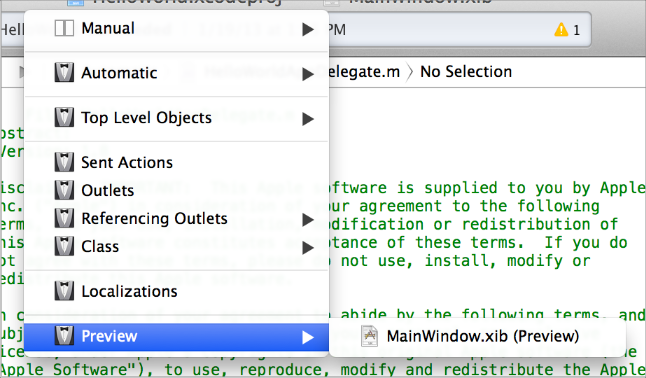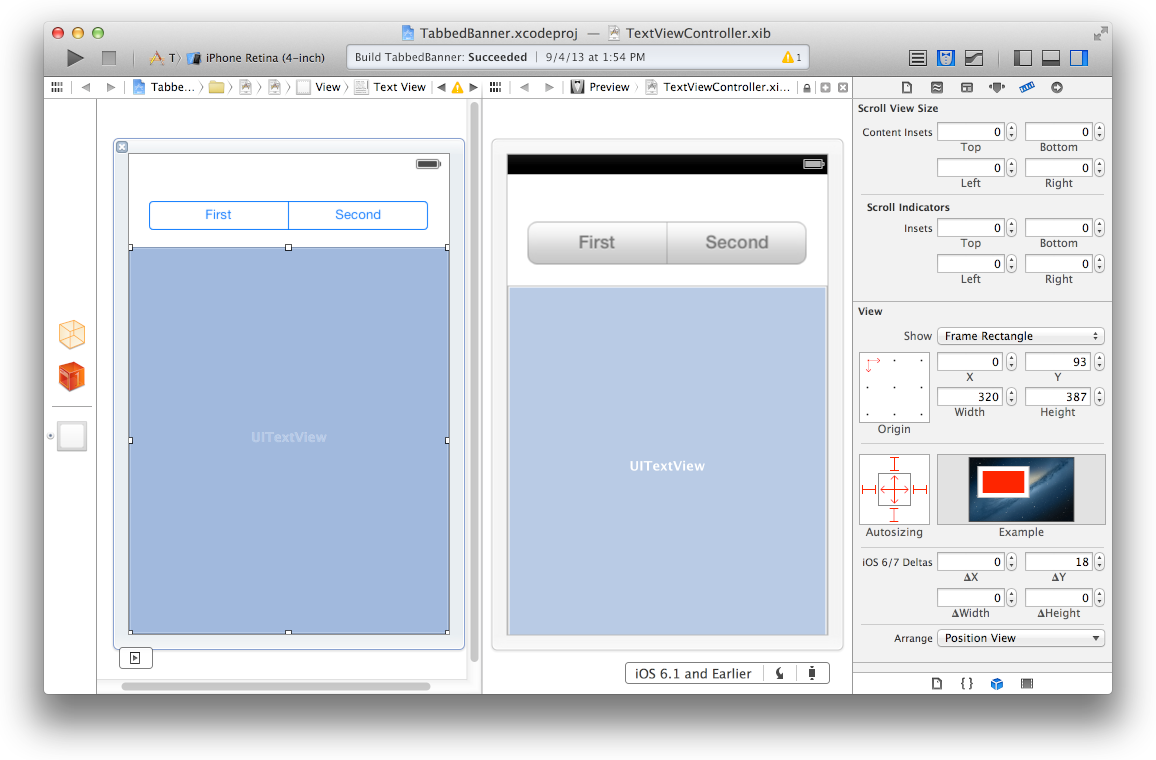Project support for both iOS 6 and iOS 7
原文:https://developer.apple.com/library/ios/documentation/UserExperience/Conceptual/TransitionGuide/SupportingEarlieriOS.html#//apple_ref/doc/uid/TP40013174-CH14-SW1
On This Page
If business reasons require you to continue supporting iOS 6 or earlier, you need to choose the most practical way to update the app for iOS 7. The techniques you choose can differ, but the overall advice remains the same: First, focus on redesigning the app for iOS 7. Then—if the redesign includes navigational or structural changes—bring these changes to the iOS 6 version as appropriate (don’t restyle the iOS 6 version of the app to use iOS 7 design elements, such as translucent bars or borderless bar buttons).
NOTE
On a device running iOS 7, all of the system UI—such as alerts and notifications—uses the iOS 7 appearance, even if your app is currently using an earlier appearance.
Using Interface Builder to Support Multiple App Versions
Interface Builder in Xcode 5 includes new features that help you transition an app to iOS 7 while continuing to support earlier versions.
Get a preview of how the UI updates you make affect an earlier version. Using the assistant editor, you can make changes to an iOS 7 storyboard or XIB file on the canvas and simultaneously see how those changes look in the iOS 6 version of the file.
Follow these steps to preview an earlier storyboard or XIB file:
While viewing the iOS 7 storyboard or XIB file on the canvas, open the assistant editor.
Open the Assistant pop-up menu. (The Assistant pop-up menu is the first item to the right of the back and forward arrows in the assistant editor jump bar.)
In the menu, scroll to the Preview item and choose the storyboard or XIB file.

Toggle between viewing app UI in iOS 7 and iOS 6.1 or earlier. If your app needs to support iOS 6.1 or earlier, use this feature to make sure the UI looks correct in all versions of the app.
Follow these steps to switch between two versions of the UI:
Open the File inspector in Interface Builder.
Open the “View as” menu.
Choose the version of the UI you want to view.
For more information about new Interface Builder features in Xcode 5, see What's New in Xcode.
Supporting Two Versions of a Standard App
If both versions of a standard app should have a similar layout, use Auto Layout to create a UI that works correctly in both versions of iOS. To support multiple versions of iOS, specify a single set of constraints that Auto Layout can use to adjust the views and controls in the storyboard or XIB files (to learn more about constraints, see “Constraints Express Relationships Between Views”).
If both versions of a standard app should have a similar layout and you’re not using Auto Layout, use offsets. To use offsets, first update the UI for iOS 7. Next, use the assistant editor to get a preview of how the changes affect the earlier version (to open the preview, select the Preview item in the Assistant pop-up menu as described in Using Interface Builder to Support Multiple App Versions). Then, specify values that define the origin, height, and width of each element in the earlier UI as offsets from the element’s new position in the iOS 7 UI. For example, the y position of the text view shown below would have to change by 18 points in the earlier version of the UI to accommodate the greater height of the iOS 6 segmented control.

To learn more about Auto Layout, see Auto Layout Guide.
Managing Multiple Images in a Hybrid App
Hybrid apps often include custom image assets, such as bar button icons, and background views for bars or other controls. Apps can use one or more asset catalogs to manage these resources. (To learn more about asset catalogs, see Asset Catalog Help.)
NOTE
An asset catalog contains resources that are displayed within an app; an asset catalog doesn’t hold the app icon, launch image, or any other image that an outside process needs to access.
In a hybrid app that must support multiple versions of iOS, you manage the images yourself. Images that differ depending on an app’s version should have unique names; otherwise, you can use the same image in both versions.
If your storyboard or XIB file contains an embedded image, consider creating an outlet to the image view and loading the appropriate resource as needed. To learn how to load different assets in code, see“Loading Resources Conditionally”.
Loading Resources Conditionally
In some cases, you need to determine the iOS version your app is currently running in so you can respond to version differences appropriately in code. For example, if different versions of an app use significantly different layouts, you can load different storyboard or XIB files for each version. You may also need to use different code paths to handle API differences, such using barTintColor instead of tintColor to tint a bar’s background.
NOTE
In iOS 7, an app can use a different launch image depending on which version of iOS it’s running in. To provide different launch images, add the UILaunchImages key to the Info.plist file and use a dictionary to describe each launch image. To learn more about handling launch images, see “App Launch (Default) Images” in iOS App Programming Guide.
If you need to load different resources for different app versions—and you currently identify a storyboard or XIB file in your Info.plist file—you can use the version of the Foundation framework to determine the current system version and load the appropriate resource inapplication:didFinishLaunchingWithOptions:. The code below shows how to check the Foundation framework version:
if (floor(NSFoundationVersionNumber) <= NSFoundationVersionNumber_iOS_6_1) {
// Load resources for iOS 6.1 or earlier
} else {
// Load resources for iOS 7 or later
}
Project support for both iOS 6 and iOS 7的更多相关文章
- iOS 7 UI 过渡指南 - 支持续 iOS 6(iOS 7 UI Transition Guide - Supporting iOS 6)
iOS 7 UI Transition Guide Preparing for Transition Before You Start Scoping the Project Supporting i ...
- iOS开发 - 兼容iOS 10
1.Notification(通知) 自从Notification被引入之后,苹果就不断的更新优化,但这些更新优化只是小打小闹,直至现在iOS 10开始真正的进行大改重构,这让开发者也体会到UserN ...
- IOS学习之IOS沙盒(sandbox)机制和文件操作
IOS学习之IOS沙盒(sandbox)机制和文件操作(一) 1.IOS沙盒机制 IOS应用程序只能在为该改程序创建的文件系统中读取文件,不可以去其它地方访问,此区域被成为沙盒,所以所有的非代码文件都 ...
- iOS学习之iOS沙盒(sandbox)机制和文件操作1
iOS学习之iOS沙盒(sandbox)机制和文件操作 接上篇 iOS学习之iOS沙盒(sandbox)机制和文件操作(一) 我们看看如何获取应用程序沙盒目录.包括真机的沙盒的目录. 1.获取程序的H ...
- iOS 1 到 iOS 10 ,我都快老了
iOS 1:iPhone诞生 虽然很难想像,但初代iPhone在问世时在功能方面其实远远落后于那时的竞争对手,比如Windows Mobile.Palm OS.塞班.甚至是黑莓.它不支持3G.多任务. ...
- 【译】UI设计基础(UI Design Basics)--iOS应用解析(iOS App Anatomy)(三)
2.1 iOS应用解析(iOS App Anatomy) 几乎所有的iOS应用都会用到UIKit框架中的组件.了解这些基础组件的名称,角色,功能可以帮你在应用界面设计时做出更好的决策. UIKit提 ...
- IOS学习:ios中的数据持久化初级(文件、xml、json、sqlite、CoreData)
IOS学习:ios中的数据持久化初级(文件.xml.json.sqlite.CoreData) 分类: ios开发学习2013-05-30 10:03 2316人阅读 评论(2) 收藏 举报 iOSX ...
- IOS 动画专题 --iOS核心动画
iOS开发系列--让你的应用“动”起来 --iOS核心动画 概览 通过核心动画创建基础动画.关键帧动画.动画组.转场动画,如何通过UIView的装饰方法对这些动画操作进行简化等.在今天的文章里您可以看 ...
- IOS开发笔记 IOS如何访问通讯录
IOS开发笔记 IOS如何访问通讯录 其实我是反对这类的需求,你说你读我的隐私,我肯定不愿意的. 幸好ios6.0 以后给了个权限控制.当打开app的时候你可以选择拒绝. 实现方法: [plain] ...
随机推荐
- P2P视频模块
P2P视频模块数据手册 公 司 : 深圳市万秀电子有限公司 网 站 : http://www.wanxiucx.com 总 机 : 0755-23215689 联系人: 张先生 手 机 : 1 ...
- 02 整合IDEA+Maven+SSM框架的高并发的商品秒杀项目之Service层
作者:nnngu 项目源代码:https://github.com/nnngu/nguSeckill 首先在编写Service层代码前,我们应该首先要知道这一层到底是干什么的. Service层主要负 ...
- Java 中判断类和实例之间的关系
判断类与实例的关系有以下三种方式 1.instanceof关键字,用来判断对象是否是类的实例 (对象 => 类 ) 2.isAssignableFrom,用来判断类型间是否存在派生关系 (类 ...
- Java Map用法
Map简介 将键映射到值的对象.一个映射不能包含重复的键:每个键最多只能映射到一个值.此接口取代 Dictionary类,后者完全是一个抽象类,而不是一个接口. Map 接口提供三种collectio ...
- 如何用vue实现树形菜单?
在公司培训了2周,布置的作业是从树形,grid分页以及echarts中选一个.由于都不是很熟,就挑了第一个.本来想在网上找找参考,然后模仿着做一个,但是网上的代码多少参差不齐,写到一半没了,所以只要自 ...
- python 闭包初识
def func_100(val): passline = 60 if val >= passline: print('pass') else: print('failed') def func ...
- linux_系统调优
linux如何调优? 1. 关闭SELLinux功能,美国国家安全局对于强制访问控制实现,生产场景也是关闭 cat /etc/selinux/config | grep '^SELINUX=' # 查 ...
- 【转】SHELL variables default value, ${var:-DEFAULT}和${var=DEFAULT}的一点区别
${var:-DEFAULT}和${var=DEFAULT}的区别: ${var:-DEFAULT} If var not set or is empty, evaluate expression a ...
- Struts2如何搭建?
如何搭建Struts2: 1.导入jar包 commons-fileupload-1.3.jar commons-io-2.0.1.jar commons-lang3-3.1.jar freema ...
- HTTP请求和MIME介绍
HTTP请求和MIME介绍 HTTP请求由三部分组成,分别是: 请求行,消息报头,请求正文. 请求行(格式): Method Request-URI HTTP-Version CRLF Method: ...
